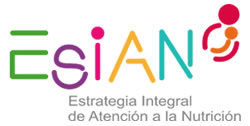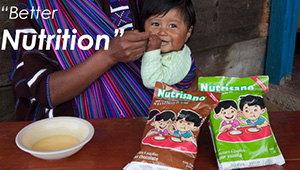The “Great SBCC Example” below was featured during the Designing the Future of Nutrition Social and Behavior Change Communication Conference and can be used as a learning aid or as an illustration of key concepts from country-level experts attending the conference.


Background
Mexico struggles with a double burden of malnutrition. In the communities where the Prospera program works, nearly 34% of children under five years are stunted and 25% are anemic. One of every five pregnant women suffers from anemia and three of four adult women are overweight or obese. In urban areas, only one of seven children under six months of age is exclusively breastfed.
Prospera, formerly known as Progresa or Oportunidades, is a national conditional cash transfer program. EsIAN is a pilot program within Prospera that aims to strengthen Prospera’s health and nutrition component by addressing the nutritional transition in Mexico and improving the health and nutrition of beneficiaries, with a focus on the first 1,000 days. This brief focuses on the pilot of the EsIAN strategy in four states. Currently, the EsIAN national strategy is being scaled-up nationwide.
Description of Intervention
EsIAN aims to decrease anemia, overweight and obesity, and stunting in children under five, and future chronic diseases among pregnant and lactating women and children under five. EsIAN is a multisectoral (health and social development), scalable, systems approach. The three components of the EsIAN strategy are (a) supplementation for pregnant and lactating women (tablets) and children aged 6–59 months (micronutrient powder, fortified porridge and milk), (b) improved health systems (specifically, equipment and quality of nutrition counseling), and (c) behavior change communication and training.
Design Process
Because the program worked within the health system, formative research was conducted both with the health workers (HWs) who would deliver the intervention as well as with the beneficiaries. Formative research with HWs identified (a) practices related to growth promotion and counseling, (b) barriers and opportunities for health promotion during primary care services, (c) mapping of actors, and (d) communication channels. Formative research with mothers, female community leaders, and fathers identified (a) maternal and infant feeding practices, including perceptions, motivations, barriers, beliefs, opportunities, and practices of nutrition behaviors, (b) traditional and social norms in communities, and (c) communication channels.
Design Strategies
The intervention was designed to respond to the findings of formative research, including these insights:
- Each category of influencer has different advantages and constraints: For families, doctors were a credible source of information but were subject to high turnover and time constraints. Nurses were less subject to turnover and were closer, physically and demographically, to the target population but also experienced time constraints. Health promoters were recognized as sources of health information by mothers and had good communication skills yet also lacked sufficient time. Community volunteers often had social recognition and were beneficiaries themselves, yet faced knowledge and time constraints.
- HWs face major constraints: The main barriers for HWs in promoting good practices included lack of knowledge, motivation, incentives, and supervision.
- Mothers are constrained by key gaps as well as negative influence: The main barriers for mothers in using good practices included lack of knowledge, confidence, support, and influential family members.
EsIAN followed an interactive, researched, planned, and systems-thinking process. The pilot utilized three behavior change models, the socio-ecological model, the social cognitive theory and the theory of planned behavior, to guide program design and decisions. Research was used to understand the target audience, drive the strategy and generate content. Central to the strategy was a plan to pilot, assess, and adjust.
Design Constraints
- Health workers had limited time available for patient counseling and were often overwhelmed by the number of behaviors and messages to address during counseling sessions.
- The high turnover rate of personnel affected efforts to deliver key messages to the communities.
Implementation Strategies
- Use an overall systems approach to build on existing resources, improve tools, skills, staff/infrastructure, and routine activities.
- Focus on prevention rather than treatment and integrate nutrition into primary care services.
- Provide specific tools and materials for each level of HW, update/standardize communication materials, and provide consistent messages at all levels.
- Focus on a few priority key behaviors and create mutually reinforcing messages for different levels of the intervention, including communication materials for health workers, billboards, TV and radio spots, and advertisements on buses.
- Use different interventions to address beneficiaries according to life stage.
- Develop standardized blended training for HWs, including in-person and online training modules.
- Clearly define roles and responsibilities among HWs and shift tasks among the varying levels of HWs.
- Implement blended trainings and integrate supervision and monitoring into training approach.
Evidence of Effectiveness
Results of the pilot study in four states, measuring frequency of behaviors in 2012 compared to baseline in 2010, showed improved HW counseling skills in the areas of exclusive breastfeeding (62%), breastfeeding on demand (41%), and breastfeeding techniques (67%). Additionally, anemia decreased in children 6–23 months of age (7% decrease in urban areas, 28% decrease in rural areas) and in children 24–59 months of age (5% decrease in urban areas, 7% decrease in rural areas). Prospera reached 6.1 million families, or 26 million people, and trained more than 191,000 health workers.
Lessons Learned
- Developing an enabling government environment was key to facilitate the use of pilot test results to improve the intervention’s design and implementation, ensure commitment necessary for scaling up, and secure adequate funding.
- Integration within the health system was key to reaching a large population and ensuring implementation funding.
- Prioritize key behaviors for messaging by impact and likelihood of adoption.
Key Takeaways for Nutrition Social and Behavior Change Communication
- Use a multi-sectoral approach: Dividing responsibilities among the Ministry of Health, Ministry of Education, the sub-national government, and social development programs and organizations enabled each to leverage resources and contribute to the effort based on defined responsibilities.
- Create public-private partnerships to fund mass media campaigns: Funding constraints can be overcome by incorporating private funding mechanisms to strengthen community mobilization efforts.
- Garner government support at the national and sub-national levels to create an enabling environment for national scale-up, commitment, and resources.
- Focus on fewer behaviors and messages: Narrowing the scope of the intervention allowed for greater impact.
Organization/Program: Prospera/EsIAN
Prospera is a national conditional cash transfer program that aims to improve the utilization of public services by low-income households in Mexico across the health, education, and social development sectors. EsIAN is a national strategy to strengthen the health and nutritional component of Prospera by addressing undernutrition and obesity, with a focus on the first 1,000 days of life.